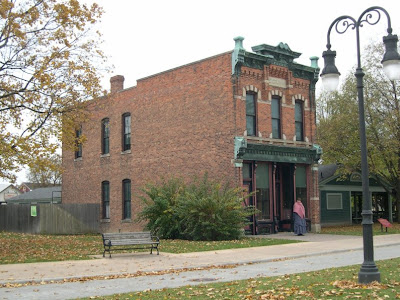Loranger Gristmill
 Henry Ford purchased the 1832 Loranger Gristmill, located on Sunny Creek near Monroe, Michigan, in January of 1928. It was one of the few structures moved to the Village without prior disassembly. Ford added a wing during its reconstruction in the Village to house the new power source: a steam engine and boiler.
Henry Ford purchased the 1832 Loranger Gristmill, located on Sunny Creek near Monroe, Michigan, in January of 1928. It was one of the few structures moved to the Village without prior disassembly. Ford added a wing during its reconstruction in the Village to house the new power source: a steam engine and boiler. 
During the Village's restoration in 2003, this Ford-added power source edition was removed, and a traditional water wheel and a relocation to a newly formed creek had taken place - one of the very few segments of said restoration that I agree with. (The photo directly above is of Ford's version. All other photos were taken after the 2003 restoration).

From colonial times and into the first half of the nineteenth century, gristmills flourished in America by meeting an important local need in agricultural communities: grinding the farmers' grain with large, circular stones, and levying a toll, usually in kind, for the service. This particular mill was originally constructed by Edward Loranger, a brick mason from Quebec, who originally came down to help erect a church. Loranger stayed on in the new country, feeling the new settlement needed a grist and saw mill. He himself hewed oak timbers for beams, cut with a broad axe the whitewood siding of the building, and cut logs for a dam in the river to impound the water for power to turn the wheels.
 In some especially productive localities, mills grew large and millers operated as merchants, buying and exporting the area's surplus grain. Beginning in the mid-nineteenth century, however, the opening of the great grain-producing areas of the West, railroad construction, steam power, and the growth and concentration of industry eventually drove most of the small local mills out of business.
In some especially productive localities, mills grew large and millers operated as merchants, buying and exporting the area's surplus grain. Beginning in the mid-nineteenth century, however, the opening of the great grain-producing areas of the West, railroad construction, steam power, and the growth and concentration of industry eventually drove most of the small local mills out of business. After the Village opened to the general public in 1933, the interest and activity around the Loranger Gristmill grew as the sights and sounds of the spinning, grinding wheels gave the public a first-hand glimpse of an earlier age. The turning wheels could grind one barrel of flour (whole wheat or buckwheat) or corn meal an hour. Some of the milled grain was used locally while the rest was packaged in three pound sacks and sold to the public.
After the Village opened to the general public in 1933, the interest and activity around the Loranger Gristmill grew as the sights and sounds of the spinning, grinding wheels gave the public a first-hand glimpse of an earlier age. The turning wheels could grind one barrel of flour (whole wheat or buckwheat) or corn meal an hour. Some of the milled grain was used locally while the rest was packaged in three pound sacks and sold to the public.An early portrayal of living history.
The mill sits now as a museum piece: the grinding wheels are there, but they no longer grind; the water wheel spins, but just for show; the store no longer sells flour or corn meal.
Maybe one day that will return.
(If you would like to see, hear, and feel an actual working gristmill in action, there is still one at Crossroads Village, where folks can still purchase sacks of flour ground right there on the spot.)
.




Comments
KS
I was just in today, but I will be back in September - I will make sure I stop in to see you!